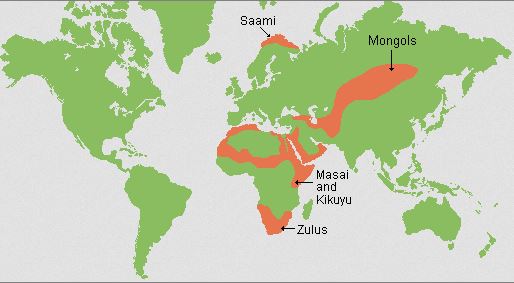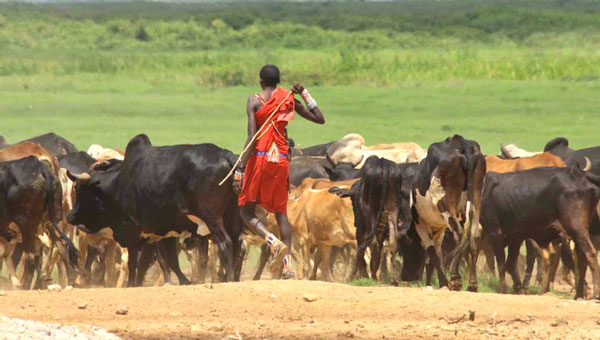Nomadic pastoralism refers to the keeping of livestock for subsistence purpose. This is done by nomadic communities. They move from one place to another in search of pasture and water for their livestock. Pastoralists depend on the animals they keep for food and for their entire livelihood. The livestock are first grazed on the plains until all the pasture is finished. As drought sets in, they move to cooler upper slopes. This movement from the plains to the hills according to seasons is known as transhumance.
Here is a map showing areas of the world where pastoral communities are commonly found.

The main factors infuencing pastoralism in Africa are:
1. Culture: Most communities that practise pastoralism do so because it is their way of life. When adults in the communities die, the herds of cattle are passed on to those left behind.
2. Pests and diseases: Most areas occupied by pastoralists are those that do not have high incidences of pests and diseases.
3. Space: Pastoralists need a lot of space to graze their animals. Therefore they occupy semi-arid areas that are sparsely populated and cannot be used for other forms of agriculture.
4. Climate: Most pastoralist communities occupy areas that receive low rainfall. These areas are not good for settlement and for crop farming. Therefore, population is low.
5. Market. There is a ready market for products like meat and hides.
6. Communical ownership of land allows free movement of pastorists as they graze their animals.
7. The breeds of cattle kept are hardy enough to survive the harsh hot and dry conditions.
8. Availability of pasture and water for their animals.
The Maasai are a pastoralist community that occupies the drier parts of Southern Kenya. They also occupy parts of Tanzania.
Other pastoralist communities in Kenya include: the Turkana, Samburu, Pokot, Rendille and Borana.
The Maasai depend on their animals for food. They also sell them to get money to pay for their other needs. Cattle are paid as dowry for the bride in the Maasai culture. People with large herds of cattle are greatly respected in the society and can be chosen to be leaders. Besides cattle, some Maasai also keep sheep, goats and camels. They use camels and donkeys to carry their belongings as they move from one place to another.
The maasai in Kenya.

The Tswana are mainly found in Botswana.
In Botswana, cattle rearing is one of the most important economic activities especially in the Western part. This is because the country experiences hot and dry conditions throughout the year. There is always need for animals to move from one place to another in search of pasture, hence, pastoralism is practised. This is mainly done in areas that have low population.It is also practised in areas that do not have pests and diseases.
During times of prolonged drought, when water and grass is not enough, pastoralists suffer greatly and lose most of their animals. Animal products account for over 80% of Botswana’s exports and as a result, the government supports pastoralism. Pastoralists use traditional methods and grazing lands are owned by the community. Because the cattle herds are large, there is often overgrazing.
The main cattle breeds kept are the Tswana cow and the Brahman bull. Because both are local breeds and are resistant to diseases like foot and mouth disease, rinderpest and East Coast Fever. Some animals have been cross-bred to produce higher breeds of animals.
a) It buys animals from pastoralists at improved prices. This protects them
against any loses.
b) It helps to control pests and diseases by spraying the grazing areas.
c) It provides markets for animal products. It also helps the pastoralists to fi nd markets
overseas.
d) It ensures that pastoralists get inputs and services at a reduced price.
e) It ensures that all animals are vaccinated. Pastoralists who don’t follow this law are fined heavily.
f) It helps farmers to buy high quality bulls to improve the quality of their herds.
The Fulani live in Western Africa. They move across Senegal, Mali, Burkina Faso, Niger,Northern Nigeria, Chad and Cameroon. These areas often experience long periods of drought. Therefore, pastoralists have to move from one place to another looking for pasture and water for their livestock. This is the reason why they cross many countries each year searching for water and pasture. In Nigeria, pastoralist communities occupy the drier parts of the country bordering the Sahara Desert. They practice transhumance by moving to highland areas during the dry seasons and returning to the plains during the rain seasons.
The animals reared in the North supply meat to the coastal towns in the South. The Fulani animals are mainly for meat. The farmers sell their animals during droughts and use the money to pay for their basic needs. Sometimes the crop farmers in the South allow them to move South and graze on the maize stocks after harvest.
Ready market for beef animals and their products.
Pests and diseases: The most dangerous pest for livestock farming is the tsetse fly which causes a disease called Trypanosomiasis or Nagana in animals.
Overgrazing: Pastoralists believe in keeping large numbers of animals. This causes overgrazing. This is because animals eat all the vegetation to the roots.
Drought: Long periods of drought leave the animals without enough grass and water.
Conflict: Many pastoral communities in Africa live near national parks. This causes conflict because wild animals like lions and leopards kill their livestock. To control this, pastoralists kill the wild animals.
Insecurity: Neighbouring pastoralist communities raid each other and take away livestock. In Eastern Africa, this is known as cattle rustling.
Market: Livestock markets are far away from areas where pastoralists settle. Therefore, animals have to walk long distances to the market.
Various governments have shown interest in the activities of nomadic pastoralists in recent years. Some of these efforts include: